- Home
- Simon Winchester
Atlantic Page 5
Atlantic Read online
Page 5
The great continent unzipped, though not like a fly on a pair of pants. It was an inelegant, jerky process, rather like watching a camel getting to its feet, with one part of the ocean opening, then another far away, then a portion of the middle, then another section in the distance, and then back to the middle again. The first waves of water washed the shores of eastern Canada and northwest Africa as they pushed apart from each other, almost at the very beginning of the Jurassic, 195 million years ago. This was the first true moment of the Atlantic Ocean’s life.
Twenty million years on, the process of sea-floor spreading got under way in earnest, in the middle of the sea—like two unrolling carpets, or two unspooling conveyor belts running away from each other from a vague submarine midpoint. The bottom of the sea started to split open, and its two halves began to diverge, the continents on either side shifting steadily apart. West Africa shifted itself about three hundred miles away from South Carolina; Mali moved a couple of hundred miles off Florida; there was a large stretch of wide-open ocean around where the Windward Islands would eventually be, and then a gap of almost a thousand miles opened between Liberia and Venezuela. In this midsection a body of seawater as large as today’s Mediterranean was created, and yet unlike the rather stable-sized Mediterranean, this body only continued to get bigger.
By 150 million years, continuing a Canaveral-style countdown, Greenland5 had begun to pull away from Norway, and Iceland began to be built up from deep down in the sea. (The spectacular eruption that began in the spring of 2010 from Eyjafjoll, an Icelandic volcano that had been quiet for the previous two centuries, and which disrupted air traffic across northern Europe with its immense swaths of high-altitude volcanic dust, is part of the process of building up. Surtsey, an entirely new island born just a few miles away in 1963, may have provided somewhat clearer evidence of the steady swelling of Iceland, but Eyjafjoll produced much more lava, even if most of it was blasted high into the sky.)
At the same time the shallow waters off the northern parts of the British Isles had deepened, and serious wave-tossed oceanic expanses now separated Ireland from Labrador. By ten million years later, Guinea, the Gambia, Senegal, and Sierra Leone had pulled relentlessly away from the coastlines of the putative Guyana, Surinam, and French Guiana, which would occupy a similar dependent position in South America. Hitherto they were in the same place: five hundred miles of ocean now separated them.
By the early Cretaceous, 120 million years back in time, the conveyor-belt-unrolling-carpet mechanism that was now evidently driving the entire process—for there was to be no further dramatic volcanism to complicate matters—had an apparent source: the Mid-Atlantic Ridge had been formed. This linear bulge in the seabed, its center fissured and faulted and alive with submarine volcanoes, would play a vital role for the rest of the ocean’s history. It was the place where new crustal material would be belched out of the inner earth, where the ocean floor to the east and the west of it would spread out and away, and where islands—a long string of them, the Azores, the Canaries, St. Helena, Fernando do Noronha, Tristan da Cunha, a jagged line stretching from Jan Mayen in the far north to Bouvet Island, 9,200 sea-miles away to the south6—occasionally poked their peaks above water level, only to be pushed away in their turn to end up, remote and mostly unpeopled, in the new ocean’s farther reaches.
And still the opening went on. Fifty million years more, and the north and middle portions now began to create and separate the southern coasts of Africa and South America. There was at first another sudden outbreak of volcanic activity—floodplains of basalt poured from numberless vents. But then separation began down here, too, though it is still not clear if this was connected with the volcanic spasm. And here the process did indeed look like the unzipping of a fly, and it was accomplished with similar speed. It was an opening up that rippled southward, one coastline following hard on another. Nigeria stripped itself away from Brazil. The valleys that would one day house the Congo on one side and the Amazon on the other snapped apart. The flood basalts of the southern edge of Pangaea separated into two: on one side the enormous Etendeka Traps, which would come to lie in southern Africa—and over the edge of which the Victoria Falls now cascade—and on the other the Paraná basalts of Argentina, currently home to the sprawling spray curtains of the falls the Guarani called big waters, the Iguazu.
And then in a final protracted frenzy of tearing, all of eastern Patagonia wrenched itself away from Angola, and the flatlands that were then off Cape Horn freed themselves from their geological embrace of what is now Namibia and the South African cape, and swept away to become the foothills of the southern Andes.
This was all accomplished at a remarkable speed, for though in the north matters unfolded in a somewhat leisurely fashion, down south they raced almost breathlessly. The Atlantic coastlines that had once been welded together between the bulge of Brazil and the armpit of Africa—the apparently natural fit that led nineteenth-century figures like Alfred Wegener to think out loud that continents might once have moved apart, thoughts that condemned him to live in near-universal and near-perpetual ridicule—had managed in a scant forty million years to spring five thousand miles apart from one another. The sea in these parts must have opened up at rather more than four inches a year—infinitely more rapidly than the separation that took place up in the brisk waters of the North Atlantic, and more than three times the rate at which the ocean continues to spread wider today.
And that movement has never ended. The outline of the Atlantic Ocean that we know today was fixed perhaps ten million years ago, and though to us and our cartographers it appears to have retained its boundaries, its coastlines, and its “look” ever since the days of Columbus and Vespucci and the great German map of Martin Waldseemüller that first defined it, it has been changing, subtly and slightly, all the time. Coastlines in the east continue to advance, those in the west to retreat. Things fall apart: the center cannot hold. The Mid-Atlantic Ridge continues to disgorge untold tonnages of new ocean floor; some of it appears above the water’s surface and creates new islands and reefs. And the islands that do exist continue to move, slowly and slightly, away from the sea’s center.
By ten million years ago the great split was done, and the Atlantic was fully born. At some time in the distant future—but not the unknown future, as we shall see—the rocks that opened will close and the sea will be forced to go elsewhere, and it will find another home. The vast earth-ocean, with its essentially and eternally constant volume of seawater, will be obliged by continental movement to reconfigure itself, and in time other shapes and sizes of its constituent water bodies will appear. The Atlantic that was born will in due course also die.
But that will not be for a very long while. In the meantime, the Atlantic Ocean, Mare Atlanticus, the Great West Sea, is like an enormous stage set. It was ten million years ago just as it is today: a sinuous snakelike river of an ocean, stretching thousands of miles from the Stygian fogs of the north to the Roaring Forties in the south, riven with deeps in its western chasms, dangerous with shallows in eastern plains, a place of cod and flying fish, of basking sharks and blue-finned tuna, of gyres of Sargasso weed and gyres of unborn hurricanes, a place of icebergs and tides, whirlpools and sandbanks, submarine canyons and deep-sea black smokers and ridges and seamounts, of capes and rises and fracture zones, of currents hot, cold, torrential, and languorous, of underwater volcanoes and earthquakes, of stromatolites and cyanobacteria and horseshoe crabs, of seabird colonies, of penguins and polar bears and manta rays, of giant squid and jellyfish and their slow-and-steady southern majesties, the great and glorious wandering albatrosses.
The stage, now so amply furnished with all this magic and mystery, has been prepared for a very long while. The supporting cast of players, all the beasts and plants, have now mostly made their entrances. The Atlantic Ocean is open wide, its physical condition fully set, and all is ready for the appearance on stage of the creature that will give full force to the human idea of t
he great sea.
For what promises or threatens to be in relative time just the briefest moment only, the central character is set to step into the light. Mankind is finally about to confront the gray-heaving reality of all these mighty waters. To see at last, just what is going on.
Chapter One
From the Purple Isles of Mogador
At first the infant
Mewling and puking in the nurse’s arms
1. ALLUREMENTS
The Kingdom of Morocco has on its most widely used currency bill neither a camel nor a minaret nor a Touareg in desert blue, but the representation of the shell of a very large snail. The shell of this shore-living marine beast—a carnivore that uses its tongue to rasp holes in other creatures’ shells and sip out the goodness—is reddish brown, slender, and spiny, with a long spire and an earlike opening. It is in all ways rather beautiful, the kind of shell not to be idly thrown away by anyone lucky enough to find one.
Yet it was not the shell’s curvilinear elegance that many years ago persuaded directors of Morocco’s Central Bank in Rabat to place its image on the back of its 200-dirham bills. The reason for their choice, more befitting a currency note, had all to do with money and profit. For it was this curious sea creature that formed the basis of Morocco’s fortunes, long before Morocco was an organized nation.
The shell of Haustellum brandaris, or dye murex, on the 200-dirhan Moroccan banknote underscores its importance to the North African economy three thousand years ago. Phoenician traders harvested the shells from the Atlantic coast and from the mollusk’s hypobranchial gland extracted purple dye, which they sold at ports around the Mediterranean.
The Berbers of the desert were not mariners, nor were they especially interested in harvesting these snails and putting them to good use. It fell instead to sailors from far away, who came thousands of miles from the Levantine coast of the eastern Mediterranean, to realize the potential for using these gastropods to make a fortune. The great challenge would come in the business of acquiring them.
For the sea in which these elegantly fashioned beasts lived so abundantly was a body of water very different in character from the placid waters of the Mediterranean. The gastropods were generally to be found, thanks to complex reasons of biology and evolutionary magic, clinging stubbornly to the rocks and reefs in the great and terrifying unknown of the Atlantic Ocean, well outside the known maritime world, and in a place where traditional navigational skills, honed in the Mediterranean, were unlikely to be of much value. To harvest these creatures, any mariners of sufficient boldness and foolhardiness would be obliged to grit their collective teeth and venture out into the deep waters of the greatest body of water it was then possible to imagine.
But they did so, in the seventh century B.C. They did so by blithely setting sail past the Pillars of Hercules, the exit gates of their own comfortable sea, and out into the great gray immensity of the limitless unknown beyond. The sailors who performed this remarkable feat, and yet did so so casually, were Phoenicians; they used sailing ships that were built initially only to withstand the waves of their familiar inland short sea but now had to tackle the much more daunting water of an unknown long sea beyond. There must have been something remarkable about the sailors, yes; but there must also have been something even more so about these particular North African snails that made them worth so much risk.
And indeed there was. First, however, it seems appropriate to set the snails to one side and consider the lengthy and necessarily complex human journey that brought the Phoenicians to Morocco in the first place.
2. ORIGINS
Early man’s march down to the ocean began in remarkably short order. Just what impelled him to move so far and so fast—curiosity, perhaps; or hunger; or a need for space and living room—remains an enigma. But the fact remains that a mere thirty thousand years after the fossil record shows him to have been foraging the grasslands of Ethiopia and Kenya—hunting for elephants and hippos, gazelles and hyenas, building shelters and capturing and controlling lightning-strike fires—he began to trek southward through Africa, a lumbering progress toward the continent’s edge, toward the southern coastlines and a set of topographical phenomena the existence of which he had no inkling.
The weather was becoming cooler as he went: the world was entering a major period of glaciation, and even Africa, astride the equator, was briefly (and before it became very cold indeed) more climatically equable, more covered with grassland, less wild with jungle. So trekking down south along the Rift was perhaps the least complicated of early man’s explorations—the mountain ranges on each side offering him a kind of protection, the rolling grassy countryside more benign than the jungles of before, the rivers less ferocious and more crossable. And so in due course, and after long centuries of a steady southern migration, man did reach the terminal cliffs, and he did find the sea.
He would have been astonished to reach what no doubt seemed to be the edge of his known world, at the sudden sight of a yawning gap between what he knew and what knew nothing about. At the same time, and from the safety of his high and grass-capped cliff top, he saw far down below him a boiling and seemingly endless expanse of water, thrashing and thundering and roaring an endless assault against the rocks that marked the margin of his habitat. Quite probably he was profoundly shaken, terrified by the sight of something so huge and utterly unlike anything he had known before.
Yet he didn’t run yelping back to the safety of the savannah. All of the recently discovered evidence suggests he and his kin stopped where they were and made shelter on the shore. They chose to do so in a large cave that was protected from the waves below by its location well above the high-tide levels. Then—whether timidly or boldly or apprehensively we will never know—he eventually clambered down and made it onto the beach proper. Then, while keeping himself well away from the thunder of the breakers, he knelt first to investigate, just as a child might do today, the magical mysteries of the seashore tide pools.
With the cliffs of land on one side and the brute majesty of the water crashing on the other, he was briefly captivated by the entirely new world of the pools. He gazed into their depths, which were crystal clear, yet fronded with green and furtive with darting movement. He dipped his finger into the water, withdrew it, tasted—it was very different from all he had known before, not sour and brackish like the poorer of the desert wells, but not fresh and sweet, probably not good for him to drink.
But nonetheless, it supported some kinds of life. The pool, as he looked at it more closely, was furiously alive with creatures—crabs, small fish, beasts with shells, weeds, anemones. And so by the same process of trial and error that had dominated his feeding and foraging habits on land in the millennia before, he eventually discovered in the pools an abundance of food for himself and his family. It was, moreover, good and nutritious food, and it was of a kind that he could hunt without running, that he could eat without cooking, that he could gather without putting his life at risk. Moreover, and mysteriously, it was a food that was somehow magically replenished with every one of the twice-daily refillings of the small watery world that lay before him.
Inevitably, man’s fascination with this strange new aqueous universe brought him to settle by the sea. He had come at last to Pinnacle Point.
3. COASTING
The Western Cape, the administrative name for the most southerly corner of South Africa, is where the waters of the Indian Ocean blend into the cold chill of the South Atlantic. It is a fearfully dangerous coastline, heaped with shipwrecks: oil tankers too big for Suez pass south of Cape Agulhas and then hug the coastline on their way to or from the wellheads, and seem to collide with each other with a dismaying frequency, resulting usually in the spillage of much unattractive cargo and the deaths of scores of African penguins.
I have sailed in these waters and know them to be very trying. Almost all vessels like to keep close to shore to avoid the notoriously extreme waves of the deeper sea, and there are few harbors to
which one can run in the event of bad weather. The combination of crowded sea-lanes (all littered with local fishing vessels, too), of cold and rough waters, and a forbidding and havenless rockbound coastline is one that few mariners—and certainly few quasi-inept strangers, as I used to be—care to experience.
I still have my old South Africa Pilot, the blue-backed sailing directions I used on the yacht. The rather beautiful Vlees Bay it notes as a landmark lies between two rocky headlands—Vlees Point to the south and, nine miles to its north, Pinnacle Point. Back when the Pilot was written, its hydrographer-authors noted the presence near Pinnacle Point of “a group of white holiday bungalows,” noting them not for aesthetic reasons, but because they would have provided visible markers for ships making their way along the coast.
This gathering of second homes has transmogrified over the thirty years since the Pilot was written into an almighty village—the Pinnacle Point Beach and Golf Resort—devoted to costly seafront hedonism. The peddlers of the resort like to say that the sea air, the Mediterranean climate, the white water, and the peculiar local floral kingdom known as fynbos, which here renders their ironbound coastal landscape unusually attractive, all combine to transform the place into “a new Garden of Eden.”
Little do they know how apposite their slogan is. Pinnacle Point may be on the verge of enjoying fame among professional golfers and retired businessmen—but it has been known for very much longer to archaeologists consumed by the history of early man. For Pinnacle Point appears to be the place where the very first human beings ever settled down by the sea. Specifically there is a cave, known to the archaeological community as PP13B, situated a few score feet above the wave line (though not quite out of earshot of the ninth tee), where evidence has been found showing that the humans who first sheltered there did such things as eat shellfish, hone blades, and daub themselves or their surroundings with scratchings of ocher. And they did so, moreover, 164,000 years ago, almost exactly.

 The Surgeon of Crowthorne
The Surgeon of Crowthorne Korea: A Walk Through the Land of Miracles
Korea: A Walk Through the Land of Miracles The Men Who United the States: America's Explorers
The Men Who United the States: America's Explorers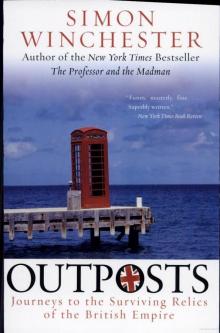 Outposts: Journeys to the Surviving Relics of the British Empire
Outposts: Journeys to the Surviving Relics of the British Empire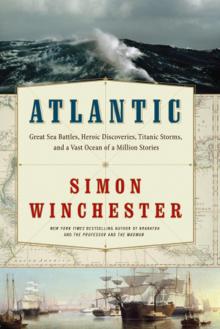 Atlantic: Great Sea Battles, Heroic Discoveries, Titanic Storms
Atlantic: Great Sea Battles, Heroic Discoveries, Titanic Storms The Professor and the Madman: A Tale of Murder, Insanity
The Professor and the Madman: A Tale of Murder, Insanity A Crack in the Edge of the World
A Crack in the Edge of the World The Perfectionists: How Precision Engineers Created the Modern World
The Perfectionists: How Precision Engineers Created the Modern World The Man Who Loved China: The Fantastic Story of the Eccentric Scientist
The Man Who Loved China: The Fantastic Story of the Eccentric Scientist The River at the Center of the World: A Journey Up the Yangtze
The River at the Center of the World: A Journey Up the Yangtze The Fracture Zone: My Return to the Balkans
The Fracture Zone: My Return to the Balkans The Map That Changed the World
The Map That Changed the World Krakatoa: The Day the World Exploded
Krakatoa: The Day the World Exploded The Man Who Loved China
The Man Who Loved China The River at the Centre of the World
The River at the Centre of the World Bomb, Book and Compass
Bomb, Book and Compass The Perfectionists
The Perfectionists The Meaning of Everything
The Meaning of Everything Exactly
Exactly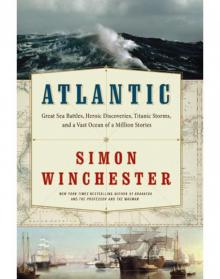 Atlantic
Atlantic Korea
Korea The Fracture Zone
The Fracture Zone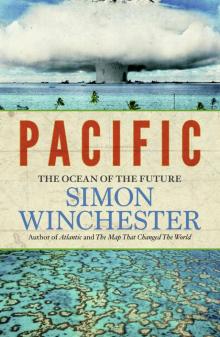 Pacific
Pacific Krakatoa
Krakatoa The Professor and the Madman
The Professor and the Madman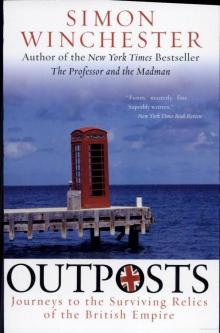 Outposts
Outposts